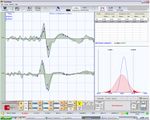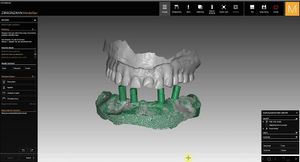Difference between revisions of "Masticationpedia:Sponsor/it"
(Created page with "testo nelle didascalie delle immagini") |
(Created page with "Figura") |
||
| Line 16: | Line 16: | ||
;''(testo nelle didascalie delle immagini)'' | ;''(testo nelle didascalie delle immagini)'' | ||
[[File:Open bite Jaw jerk.jpg|thumb|''' | [[File:Open bite Jaw jerk.jpg|thumb|'''Figura 1:''' Tracciato elettromiografico del jaw jerk sui masseteri. ''<span style="background-color:yellow">[http://www.ebneuro.com/it/ (Nemus2, NGF; EBNeuro, Firenze, Italy)]</span>''|left|150px]]<div style="display:block; width:100%; padding:3em; letter-spacing:1px "> | ||
Nihon Koden Tokyo, Japan | Nihon Koden Tokyo, Japan | ||
Although the piezoelectric-triggered hammer in use for the mandibular reflex does not provide controlled reproducibility and a quantification of the stimulus intensity, simultaneous recordings of the two sides are considered an essential method for the accurate and acceptable evaluation of the side asymmetry as can be seen in Fig.1 which represents an EMG trace of the jaw jerk (Nemus2 NGF, EB Neuro, Firenze, Italy) recorded on the right (upper trace) and left (lower trace) masseters. The latency asymmetry is very small, ranging from 0 to 1 ms with an average of 0.13 ms (SD 0.17) in 131 normal subjects. Although jaw jerk may be delayed by several milliseconds in trigeminal neuropathy or multiple sclerosis, latency asymmetries of only 0.8 ms were considered as an upper normal limit in neurological studies. (Figure 1). | Although the piezoelectric-triggered hammer in use for the mandibular reflex does not provide controlled reproducibility and a quantification of the stimulus intensity, simultaneous recordings of the two sides are considered an essential method for the accurate and acceptable evaluation of the side asymmetry as can be seen in Fig.1 which represents an EMG trace of the jaw jerk (Nemus2 NGF, EB Neuro, Firenze, Italy) recorded on the right (upper trace) and left (lower trace) masseters. The latency asymmetry is very small, ranging from 0 to 1 ms with an average of 0.13 ms (SD 0.17) in 131 normal subjects. Although jaw jerk may be delayed by several milliseconds in trigeminal neuropathy or multiple sclerosis, latency asymmetries of only 0.8 ms were considered as an upper normal limit in neurological studies. (Figure 1). | ||
Revision as of 18:03, 1 January 2021
Sulla piattaforma, la policy di Masticationpedia non permette la presenza di pubblicità o banner, ma considera tuttavia favorevolmente la sponsorizzazione etica, improntata a criteri di onestà e utilità pratica per l'utente dell'informazione trasmessa, e che viene di seguito descritta.
Nei contenuti di Masticationpedia, per ovvie necessità di esposizione, vengono spesso considerati materiali e procedure riportandone il nome del costruttore e la sede legale, né più né meno come si usa fare nelle riviste Scientifiche Internazionali; ma in Masticationpedia questi riferimenti industriali possono essere sponsorizzati dalle industrie costruttrici e perciò saranno rappresentati in ipertestuale per condurre il lettore al sito del costruttore.
Va tenuto ben presente che l'ipertestualità verso l'azienda costruttrice di riferimento non verrà attivata a richiesta dello sponsor, ma solo inserita a priori contestualmente al processo editoriale, senza alcun impegno da parte dell'industria o Istituzione. In questo modo, dunque, si lascia libero il soggetto interessato di considerare una Donazione o Sponsorizzazione al progetto Masticationpedia.
Come funziona in pratica? Abbiamo sintetizzato tre esempi nei quali i link di cui parliamo sono evidenziati su sfondo giallo (solo per questi esempi).
Esempio 1
- (testo nelle didascalie delle immagini)

Nihon Koden Tokyo, Japan Although the piezoelectric-triggered hammer in use for the mandibular reflex does not provide controlled reproducibility and a quantification of the stimulus intensity, simultaneous recordings of the two sides are considered an essential method for the accurate and acceptable evaluation of the side asymmetry as can be seen in Fig.1 which represents an EMG trace of the jaw jerk (Nemus2 NGF, EB Neuro, Firenze, Italy) recorded on the right (upper trace) and left (lower trace) masseters. The latency asymmetry is very small, ranging from 0 to 1 ms with an average of 0.13 ms (SD 0.17) in 131 normal subjects. Although jaw jerk may be delayed by several milliseconds in trigeminal neuropathy or multiple sclerosis, latency asymmetries of only 0.8 ms were considered as an upper normal limit in neurological studies. (Figure 1).
Example 2
- (Plain text)

Example 3
- (Caption)

Do you want to support us with an ethical sponsorship?
Write us at infomasticationpedia.org to receive all the information in this regard.
particularly focusing on the field of the neurophysiology of the masticatory system